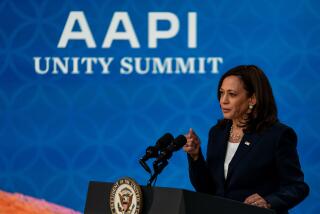‘Tea party’ tango
- Share via
The winning electoral coalition assembled by Ronald Reagan in the 1980s has been compared to a three-legged stool, the legs being social conservatives, fiscal conservatives and national security conservatives. As the 2012 Republican race takes shape, another leg has been added to the stool — the “tea party” movement.
Last week, former Massachusetts Gov. Mitt Romney announced that he was setting up an exploratory committee (though it’s hardly a secret what he’ll discover), as did former Pennsylvania Sen. Rick Santorum. Former Minnesota Gov. Tim Pawlenty seems to have decided to run, as has former House Speaker Newt Gingrich. Mississippi Gov. Haley Barbour is testing the waters. Sarah Palin continues to tantalize the party about whether she will run, and for comic relief there’s Donald Trump.
The conventional wisdom is that Republican candidates run to the right in the primaries and then reposition themselves closer to the center in the general election, when they need to win independents and moderates. But even in the primary there are distinct constituencies to which candidates must appeal; courting all of them is a balancing act that the rise of the tea party has made more delicate.
The least risky pitch is to the national security conservatives. Social and economic conservatives are unlikely to object to calls for a more muscular U.S. foreign policy carried out under the banner of American exceptionalism. Even the tea party will be receptive to that message, despite the presence in the movement’s ranks of an isolationist faction.
An appeal to fiscal conservatives is likely to be more divisive, depending on how you define fiscal conservative. Once the term referred to traditional conservatives who prized balanced budgets and were willing, however reluctantly, to raise taxes. Now “fiscal conservative” denotes the supply-side philosophy associated with Wisconsin Rep. Paul Ryan’s proposed budget, with its strong aversion to tax increases. That’s conservative enough to alienate some moderate Republicans, but as the recent debate over the budget demonstrated, tea party Republicans want even more extreme cuts in government spending. Catering to them could cost candidates the support of less extreme voters in all three categories.
The faction in the party most likely to pose difficulties for the candidates is social conservatives. Some candidates already are identified with them, such as Santorum, with his criticism of abortion and same-sex marriage and his nostalgia for the “traditional family” of pre-feminist days. Others will have to win the trust of these “values voters,” or at least their sufferance. These voters also encompass a good number of tea partyers, which increases pressure on candidates to endorse their agenda.
The problem is that, even in the primary but especially in the general election, too intimate an embrace of social conservatives will hurt a candidate with voters who reject their agenda — professional women, supporters of gay rights and abortion rights — even if those voters are conservative in other respects.
More to Read
A cure for the common opinion
Get thought-provoking perspectives with our weekly newsletter.
You may occasionally receive promotional content from the Los Angeles Times.









